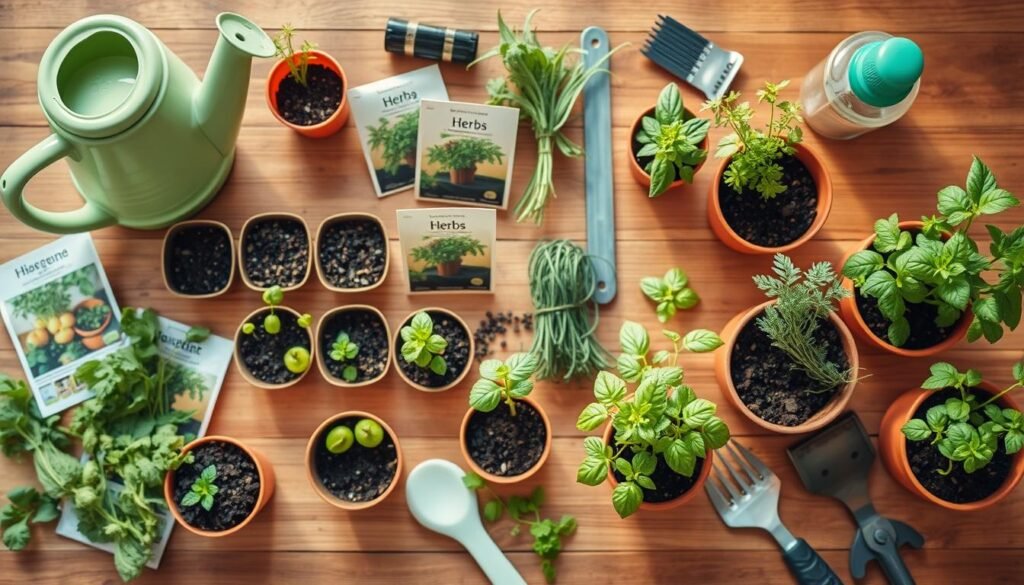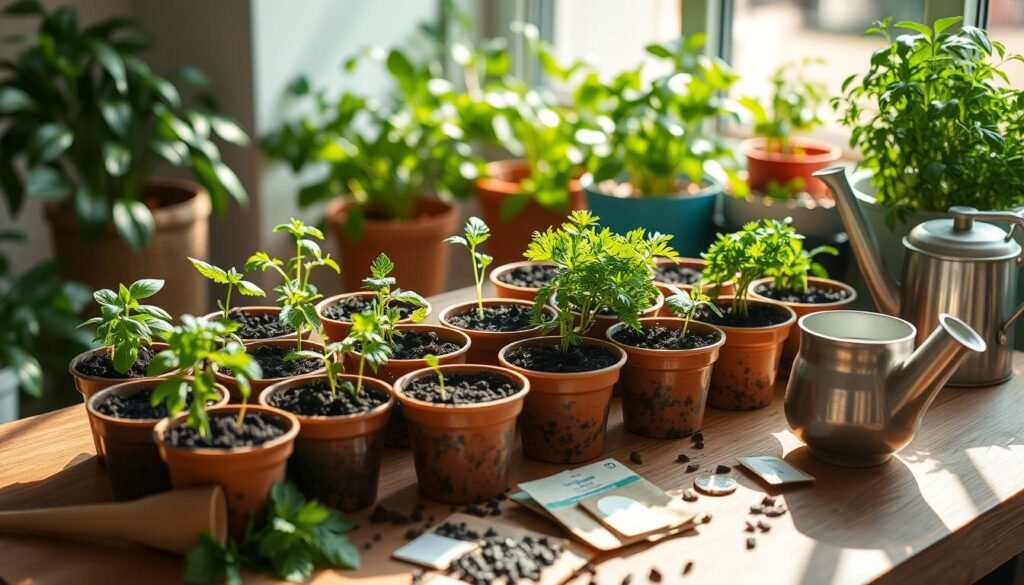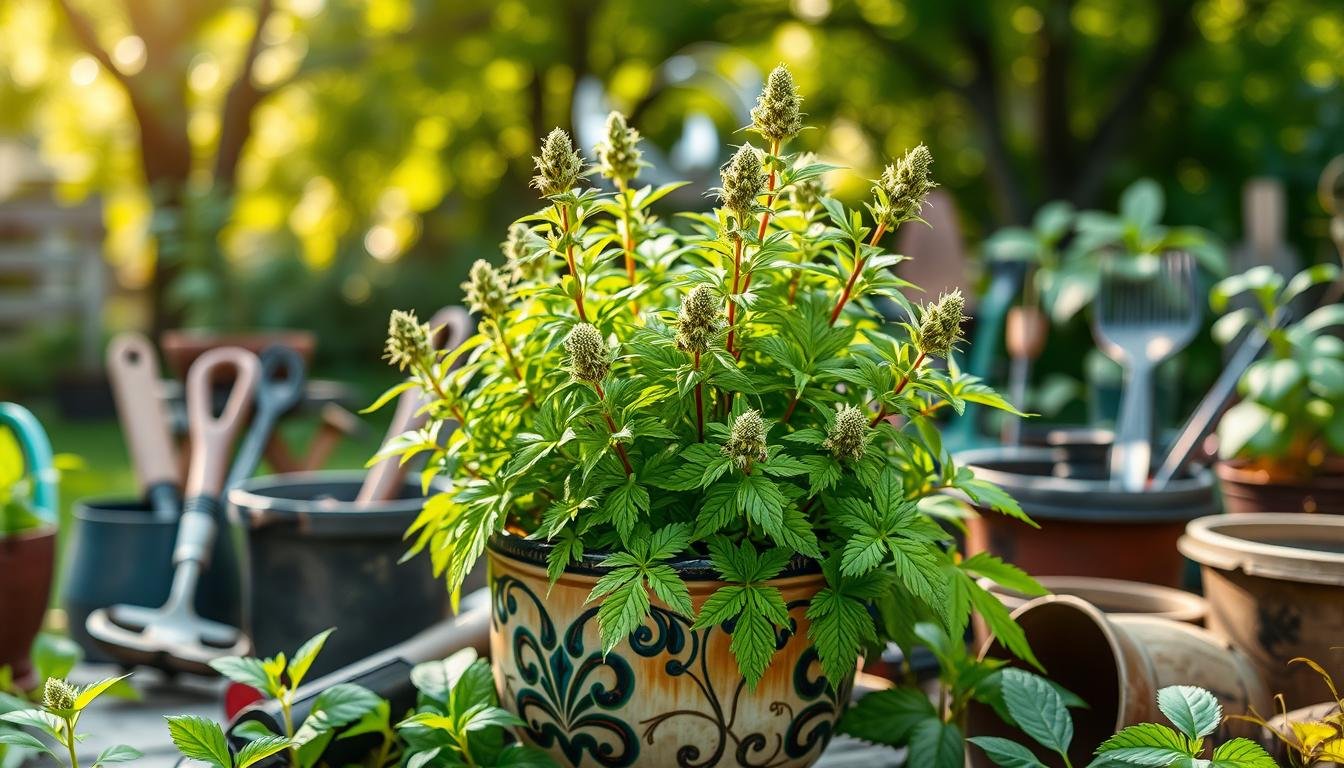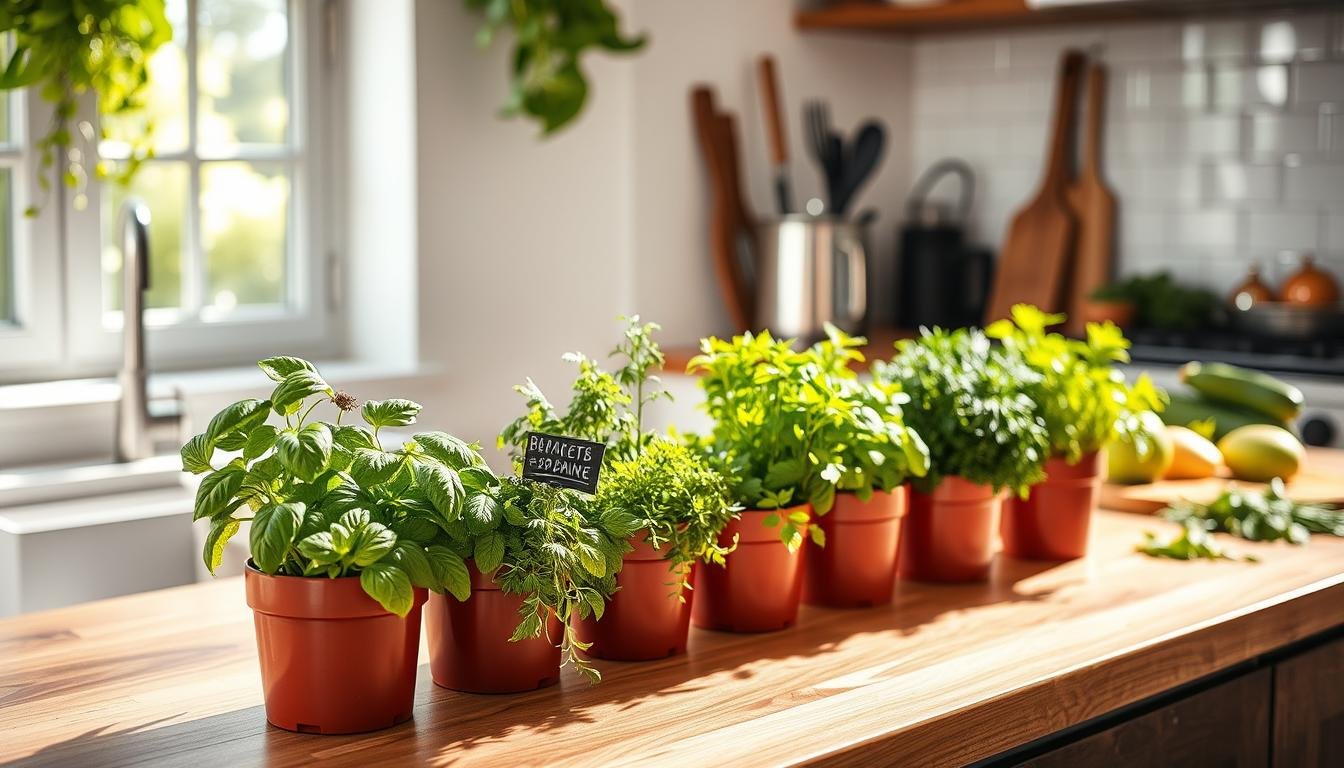Did you know nearly a third of US homes grow herbs? This shows how popular indoor herb gardening has gotten. If you’re interested in starting your own herb garden inside, this guide is perfect. With its help, you’ll learn all you need to successfully grow herbs from seeds indoors. You’ll enjoy the great taste and smell of your own herbs.
Key Takeaways
- Growing herbs indoors from seeds offers fresh and accessible flavors.
- Indoor herb gardens can improve your health and well-being.
- This guide simplifies the process for beginner gardeners.
- Choosing the right herbs is crucial for success.
- Proper maintenance ensures a thriving indoor herb garden.
Benefits of an Indoor Herb Garden
Having an indoor herb garden adds great value to your cooking and health. You get to enjoy fresh herbs anytime, making your food taste better. Fresh, aromatic herbs from your garden bring a taste that dried herbs can’t match.
Freshness at Your Fingertips
Picture this: using *fresh herbs* like basil, thyme, or rosemary straight from your garden. Their flavors are best when fresh, making your dishes stand out. With these herbs on hand, your food not only tastes better but becomes healthier. Trying out new recipes becomes fun.
Health Benefits of Home-Grown Herbs
Growing herbs yourself brings many health perks. These herbs are full of nutrients because they’re picked at their best. They have compounds that boost your health and well-being. Eating *home-grown herbs* helps with digestion and brings other health benefits too. It makes your food both tasty and good for you.
Cost-Effectiveness Compared to Store-Bought
Starting a garden with herbs is a smart money move. Buying herbs can be expensive and they may not even be fresh. But, when you grow them at home, you save money. After the initial setup, your garden keeps giving back, saving you cash.
| Benefit | Details |
|---|---|
| Freshness | Enhances flavor and aroma in cooking |
| Health | Rich in nutrients and beneficial compounds |
| Cost Savings | Reduces spending compared to store-bought options |
Choosing the Right Herbs for Indoor Growing
Choosing the right herbs can make your indoor garden succeed. Beginners often pick basil, cilantro, parsley, chives, and mint. They grow easily and don’t need much care. Knowing how much light each herb wants is very important.
Popular Herbs for Beginners
- Basil: A versatile herb ideal for cooking, needing bright light and warmth.
- Cilantro: Grows quickly and prefers moderate light, making it perfect for snug spaces.
- Parsley: Thrives well in indirect light and is an excellent choice for new gardeners.
- Chives: These herbs are hardy and can adapt to various light conditions.
- Mint: Grows rapidly in bright light and is perfect for a fresh addition to dishes.
Consider Climate and Light Requirements
It’s crucial to know what climate herbs like before planting. For example, basil and mint love bright light. But parsley and cilantro grow better in softer, indirect light. If you match herbs with their favorite conditions, they’ll grow better. Doing a little research on herb light requirements improves your garden’s yield.

Understanding Seed Planting Techniques
Grasping seed planting techniques is key for thriving indoor herbs. It’s about knowing the seed types and how to ready them. Let’s dive into the seed varieties ideal for indoors and share top tips on preparing them.
Types of Seeds for Indoor Growth
Indoor herb gardens can benefit from different seed types. Each kind offers unique benefits and caters to various tastes:
- Heirloom Seeds: Famed for their deep flavors and hardiness, heirloom seeds can yield a plentiful harvest.
- Organic Seeds: Grown without any synthetic chemicals, organic seeds are a healthier growing option.
- Hybrid Seeds: Created by mixing two plant types, these seeds can lead to more or disease-resistant plants.
Seed Preparation and Soaking
Preparing your seeds right is crucial for good starts. Soaking them is a top tip for germination. It helps by:
- Speeding up germination
- Boosting moisture intake
- Strengthening seedlings
Follow these steps for top-notch seed prep:
- Grab your seeds and put them in a water bowl.
- Soak them for 12 to 24 hours, depending on the seed kind.
- Post-soaking, take them out and let them dry a bit before planting.
Growing Herbs Indoors from Seeds: Step-by-Step Guide
Growing herbs inside can be fulfilling. It feels great when you follow a guide. This guide shows you everything. We start with picking your tools and go to planting.
Gathering Your Supplies
Start your herb garden by getting what you need:
- Seed trays or pots
- Quality potting mix for herbs
- Watering can or spray bottle
- Labels for your herbs
Preparing the Potting Mix
Choosing the right potting mix is key. A good mix is airy and drains well. This stops roots from rotting. Mix potting soil, peat moss, and perlite equally.
Optimal Planting Depth and Spacing
Knowing how deep and far apart to plant is crucial. Herbs usually need to be planted twice as deep as their seed size. Space them like this:
| Herb | Planting Depth (inches) | Spacing (inches) |
|---|---|---|
| Basil | 0.25 | 12 |
| Parsley | 0.5 | 10 |
| Cilantro | 0.25 | 6 |
| Chives | 0.5 | 8 |

Windowsill Gardening: Best Practices
Starting an indoor herb garden on your windowsill takes some planning and knowledge about light. The right spot and good lighting are key for a great garden. These tips will help make your indoor gardening better.
Choosing the Right Location
Finding the best place for your herbs matters a lot for their growth. South-facing windows give the most sunlight, which is great for plants that love the sun. Understanding the indoor gardening light requirements of your chosen herbs is important. For instance, basil and rosemary need a lot of light. On the other hand, parsley and mint like less bright conditions. Check how much sun your windowsill gets during the day to ensure your herbs get what they need.
Utilizing Natural and Supplemental Light
Getting enough natural light is crucial for your plants to flourish. If sunlight is scarce, especially during winter, think about using grow lights. These lights can make up for the lack of sunlight. Here are ways to make the most out of lights:
- Place grow lights 6-12 inches above your plants for the right amount of light.
- Use timers to give your herbs consistent light cycles.
- Opt for full-spectrum LED grow lights as they are efficient and good for plants.
With these windowsill gardening tips, you can create a great space for your herbs. Mixing natural and artificial light well can lead to healthy herb growth.
Container Herbs: Choosing the Best Pots
Finding the right containers for indoor herb gardening is important. There are many materials and designs to choose from. Knowing about different containers and drainage importance helps you grow a thriving garden indoors.
Types of Containers for Herbs
Several options work well for indoor herbs:
- Plastic pots – They are lightweight, affordable, and come in different sizes.
- Ceramic pots – Beautiful and strong, they keep roots warm but are heavy.
- Biodegradable containers – Good for the earth and great for seed starting, they go into the ground later.
- Self-watering pots – These keep moisture levels even, helping prevent too much water.
Drainage Considerations
Drainage is key for container gardening. Choose pots with holes to keep your herbs healthy. This keeps water from building up and causing root rot. Here’s what to remember:
- Pots need at least one hole for water to flow out well.
- Don’t use pots without holes as they can hold too much water and hurt plants.
- Putting gravel or stones in the pot’s bottom helps with drainage.
Picking the right pots and using good drainage methods mean your indoor herbs can grow well. You’ll have fresh herbs for cooking and more.
Watering and Maintenance for Indoor Herb Gardens
To keep your indoor herb garden thriving, balance is key. You need to water and feed your plants right. Every herb has its own water needs. By understanding these, you become a better gardener. Also, knowing when and how to fertilize will make your herbs lush and tasty.
Watering Frequency and Techniques
Each indoor herb has different watering needs. They mostly like their soil a bit moist, but not too wet. Here’s what to remember about watering:
- Check the top inch of soil for dryness before watering.
- Water early in the day to allow plants to absorb moisture effectively.
- Consider using a watering can with a spout for precision.
- Ensure pots have proper drainage to prevent waterlogged soil.
Fertilizing Your Herbs for Better Growth
Fertilizing is key to keeping your herbs growing and tasty. Use organic fertilizers made for herbs. Here are some fertilizing tips:
- Apply fertilizer every four to six weeks during the growing season.
- Follow the manufacturer’s instructions for dosage and application.
- Avoid over-fertilizing, which can lead to unhealthy plant growth.
Microgreens as a Space-Saving Alternative
Microgreens are great for anyone wanting to save space and eat fresh greens. They’re perfect for tight spaces, letting you grow nutritious crops indoors quickly. Beginners find microgreens an easy start to indoor gardening.
Best Microgreens for Beginners
Here are some top choices for those new to growing microgreens indoors:
- Pea Shoots: They’re sweet, tender, and very easy to grow.
- Radish Greens: These spicy greens don’t need much to flourish.
- Mustard Greens: They have a zesty taste and grow fast for quick harvesting.
How to Grow Microgreens from Seeds
Here’s how to start growing microgreens from seeds:
- Choose Your Seeds: Pick the types of microgreens you want to grow.
- Prepare Your Container: Find a shallow tray with holes at the bottom.
- Soil Preparation: Use a rich potting mix and spread it evenly in the tray.
- Sowing Seeds: Spread the seeds well over the soil.
- Watering: Mist the seeds lightly so they don’t move. Keep the soil just moist.
- Light and Temperature: Put the tray somewhere bright. Indirect sunlight or grow lights work best.
- Harvesting: In one to two weeks, you can cut and eat your microgreens.
Follow these steps, and soon you’ll enjoy growing microgreens indoors. You’ll love the fresh tastes and extra nutrients they add to your food.
Exploring Hydroponic Herbs at Home
Hydroponics lets you grow fresh herbs indoors without soil. It’s a great method for both new and experienced gardeners. You can set up a simple hydroponic garden easily. Let’s talk about the benefits of hydroponics and how to get started.
Advantages of Hydroponics
One big plus of hydroponics is plants grow faster. Herbs can focus more on leaf and root growth without soil. You’ll also enjoy these benefits:
- Space Efficiency: Hydroponics saves room, perfect for growing indoors.
- Water Conservation: It uses less water since the system recycles it.
- Non-Pesticide Growth: There are fewer pests, so you might not need pesticides.
Setting Up a Simple Hydroponic System
Starting your own hydroponic garden is simple. Follow these steps to begin:
- Choose Your Hydroponic System: Pick from options like deep water culture or wick systems. Choose what’s best for your space and skills.
- Gather Supplies: You’ll need a reservoir, containers, nutrient solution, and a growth medium like rock wool.
- Set Up Your System: Put your hydroponic system where it gets plenty of light. Make sure it’s easy to reach for upkeep.
- Plant Your Herbs: Plant seeds in the medium, watch them grow, and keep nutrients balanced.
Starting a hydroponic garden is an exciting step towards innovative gardening. With the benefits and setup guide provided, you’re ready to grow hydroponic herbs at home.
Common Challenges and Solutions in Indoor Gardening
Indoor gardening can hit snags, even if you’re excited to start an herb garden. Pests like aphids or spider mites can suddenly attack your plants. Or, you might face nutrient deficiencies that slow plant growth. Spotting these issues early is key to keeping your herbs healthy. Checking your plants often helps catch pests before they become a big problem.
Knowing when to water is just as important. If plants don’t get enough water, their leaves droop. Too much water, and they might get root rot. Spotting these signs lets you find the right way to water your herbs. A regular watering schedule that fits your herbs’ needs is crucial.
Nutrient imbalances can also trip up indoor herb gardens. Yellow leaves or slow growth often point to not getting the right nutrients. Using the right fertilizers can fix these issues. Learning about your herbs’ nutritional needs helps you keep them thriving indoors.



